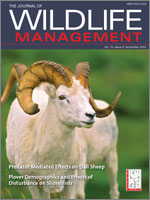 | |
| Discipline | Zoology |
|---|---|
| Language | English |
| Edited by | Paul R. Krausman |
| Publication details | |
| History | 1937–present |
| Publisher | John Wiley & Sons (United States) |
| Frequency | 8/year |
| 2.055 (2017) | |
| Standard abbreviations | |
| ISO 4 | J. Wildl. Manag. |
| NLM | J Wildl Manage |
| Indexing | |
| ISSN | 0022-541X (print) 1937-2817 (web) |
| LCCN | 51017007 |
| JSTOR | 0022541X |
| OCLC no. | 1782497 |
| Links | |
The Journal of Wildlife Management is a peer-reviewed scientific journal devoted to the ecology of non-domesticated animal species. It is published by John Wiley & Sons on behalf of The Wildlife Society.